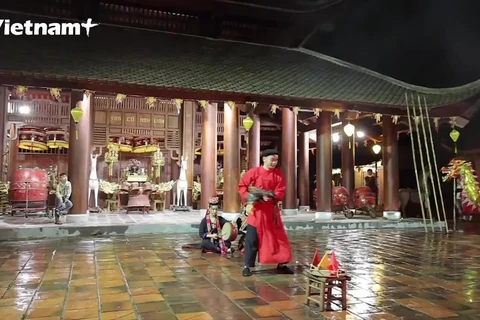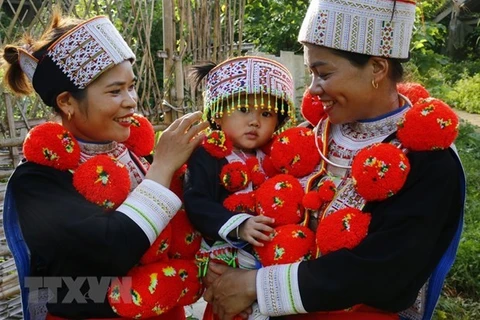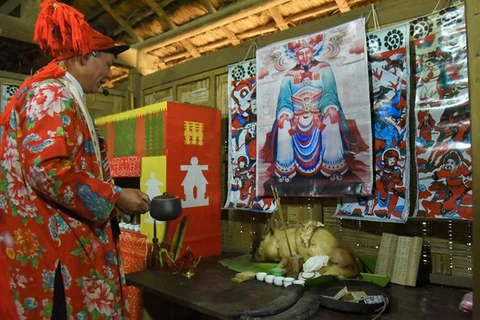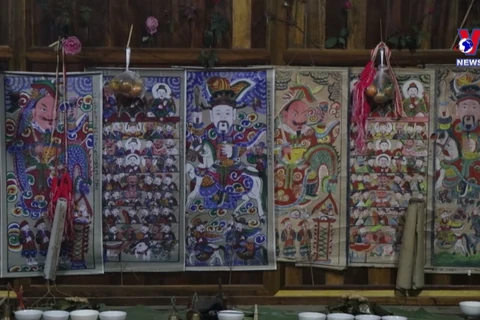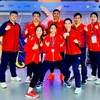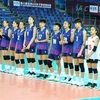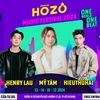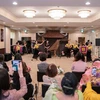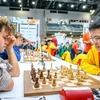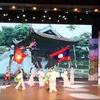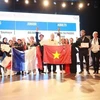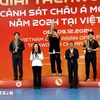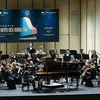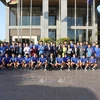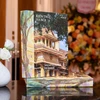 The Second National Dao Ethnic Culture Festival was held at Vo Nguyen Giap square in Thai Nguyen city in the northern province of the same name from October 6-8. A wide range of cultural, sporting and tourism activities was organised within the festival's framework from October 6-8 to promote the unique traditional culture of the Dao ethnic minority people. The Dao ethnic communities from 14 provinces and centrally-run cities across the country have come together at the festival to showcase their traditional outfits, special cuisine, and unique cultural customs. The traditional outfits of the ethnic minority people are part of their unique cultural beauty. While some have been lost as modernity takes hold, the Red Dao people have preserved their traditional outfits, cultural beauty, and customs. (Photo: VietnamPlus)
The Second National Dao Ethnic Culture Festival was held at Vo Nguyen Giap square in Thai Nguyen city in the northern province of the same name from October 6-8. A wide range of cultural, sporting and tourism activities was organised within the festival's framework from October 6-8 to promote the unique traditional culture of the Dao ethnic minority people. The Dao ethnic communities from 14 provinces and centrally-run cities across the country have come together at the festival to showcase their traditional outfits, special cuisine, and unique cultural customs. The traditional outfits of the ethnic minority people are part of their unique cultural beauty. While some have been lost as modernity takes hold, the Red Dao people have preserved their traditional outfits, cultural beauty, and customs. (Photo: VietnamPlus)  More than 1,000 artists from the Dao ethnic group participated in the event to promote their traditional cultural values. The clothes of the Dao ethnic minority people introduced at the festival are diverse. The costumes of Dao women consist of long dresses, brassieres, skirts or trousers. They are brocaded in different colours. The Dao Do (Red Dao) are a subgroup of the Dao people, renowned for their colourful traditional costumes. On a background of black clothing, the Red Dao people use four main colours - red, yellow, blue and white - to decorate their outfits. Materials include brocade and satin, with motifs close to nature. (Photo: VietnamPlus)
More than 1,000 artists from the Dao ethnic group participated in the event to promote their traditional cultural values. The clothes of the Dao ethnic minority people introduced at the festival are diverse. The costumes of Dao women consist of long dresses, brassieres, skirts or trousers. They are brocaded in different colours. The Dao Do (Red Dao) are a subgroup of the Dao people, renowned for their colourful traditional costumes. On a background of black clothing, the Red Dao people use four main colours - red, yellow, blue and white - to decorate their outfits. Materials include brocade and satin, with motifs close to nature. (Photo: VietnamPlus)  Women's costumes are usually decorated with more patterns than men's. The decorative patterns may be embroidered or made of silver. On shirts is a row of rectangular silver buttons, and engraved on the buttons is the sign of Heaven. In the Dao people's beliefs, once they wear a traditional outfit, they are always protected and blessed by God and their ancestors. The costume is buried with them when they die, and the buttons signify they will go to Heaven and return to their ancestors. The triangular decorative motifs on headscarves are imitations of the water-powered rice mill of the Dao ethnic group. (Photo: VietnamPlus)
Women's costumes are usually decorated with more patterns than men's. The decorative patterns may be embroidered or made of silver. On shirts is a row of rectangular silver buttons, and engraved on the buttons is the sign of Heaven. In the Dao people's beliefs, once they wear a traditional outfit, they are always protected and blessed by God and their ancestors. The costume is buried with them when they die, and the buttons signify they will go to Heaven and return to their ancestors. The triangular decorative motifs on headscarves are imitations of the water-powered rice mill of the Dao ethnic group. (Photo: VietnamPlus)  The Red Dao's dress symbolises their ethnicity and distinguishes them from others. They are easily identifiable by the predominance of red in their clothing, as the colour is believed to bring luck, happiness, prosperity and positive energy to everybody. The traditional Red Dao art of costume decoration in Tuyen Quang's districts of Na Hang, Lam Binh, Chiem Hoa, Ham Yen and Son Duong was recognised by the Ministry of Culture, Sports and Tourism as a national intangible heritage last year. This traditional art has a long history. In the remote villages of the Red Dao people, women still make traditional clothing for themselves and other family members. (Photo: VietnamPlus)
The Red Dao's dress symbolises their ethnicity and distinguishes them from others. They are easily identifiable by the predominance of red in their clothing, as the colour is believed to bring luck, happiness, prosperity and positive energy to everybody. The traditional Red Dao art of costume decoration in Tuyen Quang's districts of Na Hang, Lam Binh, Chiem Hoa, Ham Yen and Son Duong was recognised by the Ministry of Culture, Sports and Tourism as a national intangible heritage last year. This traditional art has a long history. In the remote villages of the Red Dao people, women still make traditional clothing for themselves and other family members. (Photo: VietnamPlus)  Dao men's costumes are designed more simply in terms of colours and patterns. Being taught the meaning of the patterns on the outfits and how to make them has helped the Red Dao people preserve the outfits and their cultural beauty. Though living with other ethnic groups, the traditional cultural beauty of the Red Dao people has been preserved, with ceremonies to pray for a good harvest, coming-of-age ceremonies, and fire dances still being held regularly. In contrast, outdated customs at weddings and funerals have been removed. Young Red Dao women are taught how to make outfits so that the beauty of their traditional costumes continues to be treasured. (Photo: VietnamPlus)
Dao men's costumes are designed more simply in terms of colours and patterns. Being taught the meaning of the patterns on the outfits and how to make them has helped the Red Dao people preserve the outfits and their cultural beauty. Though living with other ethnic groups, the traditional cultural beauty of the Red Dao people has been preserved, with ceremonies to pray for a good harvest, coming-of-age ceremonies, and fire dances still being held regularly. In contrast, outdated customs at weddings and funerals have been removed. Young Red Dao women are taught how to make outfits so that the beauty of their traditional costumes continues to be treasured. (Photo: VietnamPlus)  Besides their daily clothes, the Dao ethnic minority people also have costumes to wear on special occasions or important rituals such as "Cap sac". The "cap sac" (naming ritual) is a unique cultural feature of the Dao ethnic people. The ritual is significant in the spiritual life of the Dao people, as it marks a man's maturity and recognition from his community. The ceremony is often held between agricultural seasons. During the "Cap sac" ceremony, sorcerers use musical instruments such as drums and gongs to invite the gods to drive away any evil spirits and pray for the men's maturity. A Dao man usually passes the "Cap sac" ritual between 10 and 16 years old. (Photo: VietnamPlus)
Besides their daily clothes, the Dao ethnic minority people also have costumes to wear on special occasions or important rituals such as "Cap sac". The "cap sac" (naming ritual) is a unique cultural feature of the Dao ethnic people. The ritual is significant in the spiritual life of the Dao people, as it marks a man's maturity and recognition from his community. The ceremony is often held between agricultural seasons. During the "Cap sac" ceremony, sorcerers use musical instruments such as drums and gongs to invite the gods to drive away any evil spirits and pray for the men's maturity. A Dao man usually passes the "Cap sac" ritual between 10 and 16 years old. (Photo: VietnamPlus)  The costumes of Dao men in the "Cap sac" (naming ritual). The ritual is significant in the spiritual life of the Dao ethnic minority people, as it marks a man's maturity and recognition from his community. The ceremony is usually held between agricultural seasons. Everyone, from the elderly to children, is happy to participate in the event. They laugh, dance, and share joy. During the "Cap sac" ceremony, sorcerers use musical instruments such as drums and gongs to invite the gods to drive away any evil spirits and pray for the men's maturity. The "Cap sac" ritual was recognised as a national intangible cultural heritage in 2016. (Photo: VietnamPlus)
The costumes of Dao men in the "Cap sac" (naming ritual). The ritual is significant in the spiritual life of the Dao ethnic minority people, as it marks a man's maturity and recognition from his community. The ceremony is usually held between agricultural seasons. Everyone, from the elderly to children, is happy to participate in the event. They laugh, dance, and share joy. During the "Cap sac" ceremony, sorcerers use musical instruments such as drums and gongs to invite the gods to drive away any evil spirits and pray for the men's maturity. The "Cap sac" ritual was recognised as a national intangible cultural heritage in 2016. (Photo: VietnamPlus)  Several objects and models were also displayed at the festival, showing the material and spiritual lives of the Dao ethnic minority group. Vietnam is home to 54 ethnic groups, each of which has its own identity and unique values in terms of customs and traditions, contributing to the cultural diversity in the country. One of the groups is the Dao ethnic minority people who reside mostly in the mountainous northern provinces of Tuyen Quang, Cao Bang, Ha Giang and Lang Son. The Red Dao is a subgroup of the Dao people, renowned for their colourful traditional costumes that leave an indelible impression on visitors. (Photo: VietnamPlus)
Several objects and models were also displayed at the festival, showing the material and spiritual lives of the Dao ethnic minority group. Vietnam is home to 54 ethnic groups, each of which has its own identity and unique values in terms of customs and traditions, contributing to the cultural diversity in the country. One of the groups is the Dao ethnic minority people who reside mostly in the mountainous northern provinces of Tuyen Quang, Cao Bang, Ha Giang and Lang Son. The Red Dao is a subgroup of the Dao people, renowned for their colourful traditional costumes that leave an indelible impression on visitors. (Photo: VietnamPlus)  A set of chisels to make silver jewellery of the Dao ethnic group. It is said that the traditional costume of the Red Dao is the most famous of all in Vietnam, with a typical outfit including a tunic, trousers, headscarf, cloth belt and jewellery. Five colours – red, blue, white, yellow and black – are needed in making a traditional Red Dao costume, but red should be the most prominent. With women's clothing, the most important piece is the long indigo or black tunic with highlighted brocade patterns on the front or cuffs. The blouse, divided into four parts, reaches mid-thigh, accompanied by a belt with many coloured tassels. (Photo: VietnamPlus)
A set of chisels to make silver jewellery of the Dao ethnic group. It is said that the traditional costume of the Red Dao is the most famous of all in Vietnam, with a typical outfit including a tunic, trousers, headscarf, cloth belt and jewellery. Five colours – red, blue, white, yellow and black – are needed in making a traditional Red Dao costume, but red should be the most prominent. With women's clothing, the most important piece is the long indigo or black tunic with highlighted brocade patterns on the front or cuffs. The blouse, divided into four parts, reaches mid-thigh, accompanied by a belt with many coloured tassels. (Photo: VietnamPlus)  A set of silver jewellery of Dao women in the northern province of Bac Giang. It is said that the traditional costume of the Red Dao is the most famous of all in Vietnam, with a typical outfit including a tunic, trousers, headscarf, cloth belt and jewellery. The embroidered patterns and designs are composed of coloured trees, flowers, mountains and animals. The trousers are often in plain black and tailored with rich patterns, such as squares, rectangles, pine trees and rhombuses, in the lower parts. The most eye-catching feature must be the colourful headscarf, which is the main thing that differentiates the Red Dao from other minorities. The headscarf is folded to make it thicker and larger than many other ethnic headscarves. (Photo: VietnamPlus)
A set of silver jewellery of Dao women in the northern province of Bac Giang. It is said that the traditional costume of the Red Dao is the most famous of all in Vietnam, with a typical outfit including a tunic, trousers, headscarf, cloth belt and jewellery. The embroidered patterns and designs are composed of coloured trees, flowers, mountains and animals. The trousers are often in plain black and tailored with rich patterns, such as squares, rectangles, pine trees and rhombuses, in the lower parts. The most eye-catching feature must be the colourful headscarf, which is the main thing that differentiates the Red Dao from other minorities. The headscarf is folded to make it thicker and larger than many other ethnic headscarves. (Photo: VietnamPlus)  Several farming tools were showcased at the festival, offering visitors a chance better to understand the lives of the Dao ethnic people. Vietnam is home to 54 ethnic groups, each of which has its own identity and unique values in terms of customs and traditions, contributing to the cultural diversity in the country. One of the groups is the Dao ethnic minority people who reside mostly in the mountainous northern provinces of Tuyen Quang, Cao Bang, Ha Giang and Lang Son. The Red Dao is a subgroup of the Dao people, renowned for their colourful traditional costumes that leave an indelible impression on visitors. (Photo: VietnamPlus)
Several farming tools were showcased at the festival, offering visitors a chance better to understand the lives of the Dao ethnic people. Vietnam is home to 54 ethnic groups, each of which has its own identity and unique values in terms of customs and traditions, contributing to the cultural diversity in the country. One of the groups is the Dao ethnic minority people who reside mostly in the mountainous northern provinces of Tuyen Quang, Cao Bang, Ha Giang and Lang Son. The Red Dao is a subgroup of the Dao people, renowned for their colourful traditional costumes that leave an indelible impression on visitors. (Photo: VietnamPlus)  Several tools used in special rituals, such as the "Cap sac" of the Dao ethnic people, were also exhibited at the festival. The "Cap sac" (naming ritual) is a unique cultural feature of the Dao ethnic people. The ritual is significant in the spiritual life of the Dao people, as it marks a man's maturity and recognition from his community. The ceremony is often held between agricultural seasons. During the "Cap sac" ceremony, sorcerers use musical instruments such as drums and gongs to invite the gods to drive away any evil spirits and pray for the men's maturity. The "Cap sac" ritual was recognised as a national intangible cultural heritage in 2016. (Photo: VietnamPlus)
Several tools used in special rituals, such as the "Cap sac" of the Dao ethnic people, were also exhibited at the festival. The "Cap sac" (naming ritual) is a unique cultural feature of the Dao ethnic people. The ritual is significant in the spiritual life of the Dao people, as it marks a man's maturity and recognition from his community. The ceremony is often held between agricultural seasons. During the "Cap sac" ceremony, sorcerers use musical instruments such as drums and gongs to invite the gods to drive away any evil spirits and pray for the men's maturity. The "Cap sac" ritual was recognised as a national intangible cultural heritage in 2016. (Photo: VietnamPlus)  Dao people often buy paintings of ancestors for worshipping during traditional festivals. During traditional festivals, weddings or on the occasion of welcoming special guests to their homes, the Red Dao people often dress in their most beautiful and colourful outfits. All the patterns on a traditional Red Dao costume are hand-sewn by Red Dao women, which takes time. Each costume takes at least a year, some even up to two years. They are highly individualised yet convey a solid cultural message through each decorative pattern. The Red Dao girls are taught from the age of nine or ten how to embroider and sew. They will use these skills to attract a future husband and show their value as a wife to their families-in-law. (Photo: VietnamPlus)
Dao people often buy paintings of ancestors for worshipping during traditional festivals. During traditional festivals, weddings or on the occasion of welcoming special guests to their homes, the Red Dao people often dress in their most beautiful and colourful outfits. All the patterns on a traditional Red Dao costume are hand-sewn by Red Dao women, which takes time. Each costume takes at least a year, some even up to two years. They are highly individualised yet convey a solid cultural message through each decorative pattern. The Red Dao girls are taught from the age of nine or ten how to embroider and sew. They will use these skills to attract a future husband and show their value as a wife to their families-in-law. (Photo: VietnamPlus)  A model of the altar of the sorcerer in the "Cap sac" ritual. The "Cap sac" ritual is a rite of passage declaring the coming-of-age of Dao men. This is the most important ritual ceremony in the life of a Dao man and is a necessary part of being recognised as an adult. Only after passing can a Dao man be considered mature. Only those who pass the "Cap sac" ritual in the Dao group can become family owners or village heads and worship their ancestors. The Dao people believe that a Dao man who passes the ritual is "grown up", even though he is still quite young. He can join important community events in the village and become a teacher, sorcerer, or medical practitioner, the three jobs considered important among the Dao people. For these reasons, no matter how rich or poor he is, a Dao man must be initiated. (Photo: VietnamPlus)
A model of the altar of the sorcerer in the "Cap sac" ritual. The "Cap sac" ritual is a rite of passage declaring the coming-of-age of Dao men. This is the most important ritual ceremony in the life of a Dao man and is a necessary part of being recognised as an adult. Only after passing can a Dao man be considered mature. Only those who pass the "Cap sac" ritual in the Dao group can become family owners or village heads and worship their ancestors. The Dao people believe that a Dao man who passes the ritual is "grown up", even though he is still quite young. He can join important community events in the village and become a teacher, sorcerer, or medical practitioner, the three jobs considered important among the Dao people. For these reasons, no matter how rich or poor he is, a Dao man must be initiated. (Photo: VietnamPlus)  A glazed terra-cotta drum used in the "Cap sac" ritual. The ritual is indispensable for Dao men to be recognised as adults. Only after passing the "Cap sac" is a Dao man considered mature. An older man who doesn't pass this ritual has to sit with children on all important occasions. In Dao society, only people who pass the "Cap sac" ritual can become family owners, and village heads, and worship ancestors. A person who doesn't pass this ritual is believed not to be able to control his spirit, which consequently will hurt the destiny of his offspring. People passing this ritual are believed not to be harmed by devils when they die. (Photo: VietnamPlus)
A glazed terra-cotta drum used in the "Cap sac" ritual. The ritual is indispensable for Dao men to be recognised as adults. Only after passing the "Cap sac" is a Dao man considered mature. An older man who doesn't pass this ritual has to sit with children on all important occasions. In Dao society, only people who pass the "Cap sac" ritual can become family owners, and village heads, and worship ancestors. A person who doesn't pass this ritual is believed not to be able to control his spirit, which consequently will hurt the destiny of his offspring. People passing this ritual are believed not to be harmed by devils when they die. (Photo: VietnamPlus)  "Trong nem" (Nem drum) is a musical instrument closely linked with the cultural and spiritual life of the Dao ethnic people. Its surface is made of buffalo skin, and its body is made of wood. This musical instrument is used in special occasions such as weddings, festivals, funerals or "Cap sac" rituals. The "Cap sac" ritual is a rite of passage declaring the coming-of-age of Dao men. A Dao man usually passes the "Cap sac" ritual between 10 and 16 years old. The ritual must be held in the order of a man's position in the family: the father must have this ritual before his son, and an older brother must do it before his younger brother. In the days of the ritual, traditional dances are performed by villagers for hours to the sounds of cymbals, and drums, depicting historical events, farm work, house building and other daily-life activities. (Photo: VietnamPlus)
"Trong nem" (Nem drum) is a musical instrument closely linked with the cultural and spiritual life of the Dao ethnic people. Its surface is made of buffalo skin, and its body is made of wood. This musical instrument is used in special occasions such as weddings, festivals, funerals or "Cap sac" rituals. The "Cap sac" ritual is a rite of passage declaring the coming-of-age of Dao men. A Dao man usually passes the "Cap sac" ritual between 10 and 16 years old. The ritual must be held in the order of a man's position in the family: the father must have this ritual before his son, and an older brother must do it before his younger brother. In the days of the ritual, traditional dances are performed by villagers for hours to the sounds of cymbals, and drums, depicting historical events, farm work, house building and other daily-life activities. (Photo: VietnamPlus) VNA
